
Shameen Ebony Anthanio-Williams
Shameen Ebony Anthanio-Williams
Shameen E. Anthanio-Williams is a commissioned officer in the United States Coast Guard and a children's book author. She grew up in the Bronx and attended the LaGuardia High School of Music & Arts and Performing Arts. Next came the United States Coast Guard Academy and, in 2016, she earned the rank of Commander. Her assignments include Marine Safety & Security, Naval Engineering, and Acquisitions Management. She also holds a master of science degree from George Washington University.
Anthanio-Williams is the author of two children's books: Little Erroll: the story of Admiral Erroll M. Brown, First Black Coast Guard Admiral (2014) and Tulsa Girl (2016). Tulsa Girl is based on the memories of Dr. Olivia J. Hooker - the first African American woman in the US Coast Guard (1945), a doctor of psychology, and a civil rights activist - who as a six-year-old experienced the Tulsa race riot (massacre) of 1921. Anthanio-Williams hopes that people will learn from this history: “Our nation once again finds itself steeped in fierce racial discord, and I want all parents to sit down with their children and teach them what it actually means... I know discussing politics with children is unconventional, but you only have to look at our nation s racial tensions to see what ignorance leads to”
Sources:
Shameen Anthanio-Williams: Facebook, Linked In:
Shameen Anthanio-Williams, webpage for Tulsa Girl:
“Shameen Ebony Anthanio-Williams”, Society of Children's Book Writers and Illustrators
Everybody Wins DC's Facebook post thanking Lieutenant Commander Shameen Anthanio-Williams for sharing her book, Little Erroll: The Story of Admiral Erroll M. Brown.
“Little Erroll The Story of Admiral Erroll Mingo Brown: First Black Coast Guard Admiral,” Indiebound.org
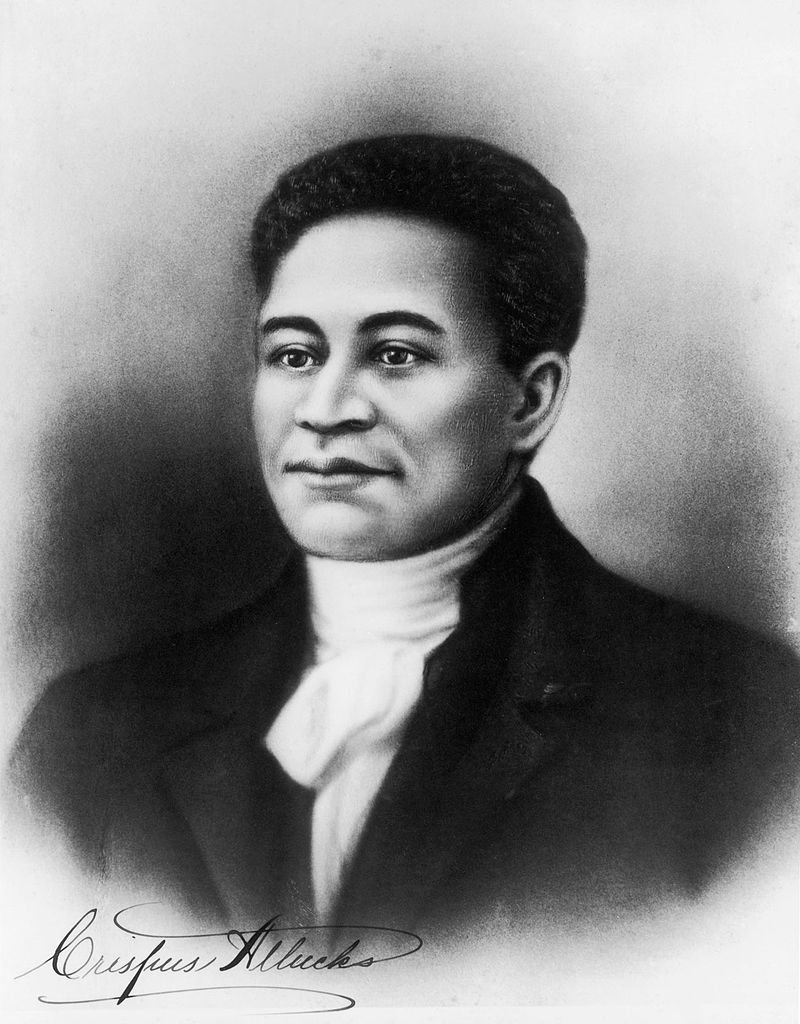
Crispus Attucks - 1723-1770
Crispus Attucks - 1723-1770
Crispus Attucks, a whaler, ropemaker and revolutionary has the unfortunate distinction of being known as the first to die in the American Revolution. Born in Massachusetts, in 1723, his father was African and his mother native Wampanoag. Enslaved at birth, at the age of 27 he escaped to Boston and became a sailor. The sailing trade was one of the few open to Blacks. It is estimated that of the 100,000 sailors employed on American ships around the time of the Revolution about one-fifth of them were African American. Whaling was a hard life, but hard for all. By the 1760s he had a home in the free black community of Providence, in the Bahama Islands.
Sailors, laborers and slaves wanted a change in the system that disrespected them and treated then unfairly. In Boston on March 5, 1770, Attucks was one of several American colonists expressing their anger to British Troops. In what is now known as the Boston Massacre, Attucks was shot and killed along with four white men. That event is considered one of the important milestones leading up to the American Revolution, and was used by revolutionaries at the time, such as Samuel Addams, as a rallying cry. Aside from slavery, a maritime reason that Attucks would have anti-British was their practice of capturing American sailors and forcibly drafting them into the British Navy. Attucks became a symbol in the Abolitionist movement in the 1840s and the Civil Rights movement of the 1960s.
Sources:
“8 Things We Know About Crispus Attucks,” by Patrick J. Kiger, History.com, March 4, 2021
“An account of a late military massacre at Boston, or the consequences of quartering troops in a populous town, March 12, 1770,” New York, John Holt, 1770. Library of Congress digital resource.
“Crispus Attucks,” Boston National Historical Park, National Park Service.
“Crispus Attucks, First Martyr of the American Revolution,” Biography. Youtube video.
“Speculative portrait of what Attucks might have looked like,” Wikipedia.
“The Revenge of Crispus Attucks; or, The Atlantic Challenge to American Labor History.” Labor Studies in Working-Class History of the Americas, December 2004
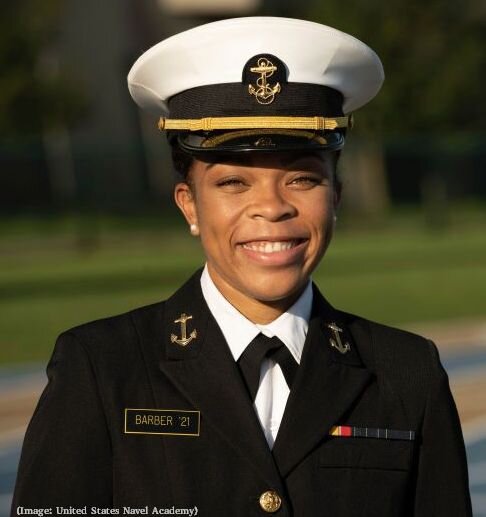
Sydney Barber
Sydney Barber
Sydney Barber became the 1st Black woman Brigade Commander of the US Naval Academy in 2020. The honor is roughly equivalent to class president but with more significance within the military. Barber, who is majoring in mechanical engineering, said of her ceiling breaking appointment: "with every step I take, I leave the ladder down for the next person."
Sources:
”Sydney Barber became the 1st Black woman Brigade Commander of the US Naval Academy in 2020.“ NPR. November 19, 2020
“Sydney Barber Becomes the First Black Woman Brigade Commander at The U.S. Naval Academy” Black Enterprise. November 11, 2020
“Black Woman, for First Time, Will Lead Midshipmen at the U.S. Naval Academy”. The New York Times, November 11, 2020
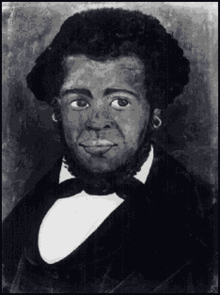
Absalom Boston (1785–1855)
Absalom Boston (1785–1855)
Absalom Boston was the first whaling ship captain to sail with an all-Black crew.
Boston was captain at a time when African-Americans were able to find work in the maritime industry. At the height of the whaling industry in the mid-1800s, about 700 Black men were either harpooners or officers on American whaling ships. A few, like Boston, sailed as captains.
Black men were more likely to be promoted on whaling ships than merchant vessels and assume more responsibility. One Black owner of a boardinghouse for seamen noted that on a whale ship, “A coloured man is only known and looked upon as a man, and is promoted in rank according to his ability and skill to perform the same duties as the white man.”
Sources:
“Captain Absalom Boston,” Voyage to Discovery, (2016 archive copy)
“Absalom Boston,” Wikipedia
“Absalom Boston: First African-American Captain To Sail A Whaleship With All-Black Crew In 1822,” Blackthen.com, 2020
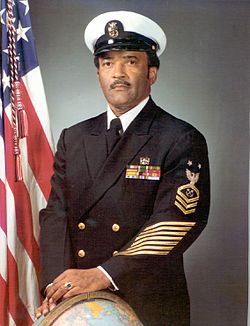
Carl Maxie Brashear (1931– 2006)
Carl Maxie Brashear (1931– 2006)
Carl Maxie Brashear, BMCM (master chief boatswain's mate) was the first African American to become a U.S. Navy Master Diver, rising to the position in 1970 despite also having an amputated left leg.
Sources:
US Naval Institute, “Brashear, Carl M., Master Chief Boatswain's Mate, USN (Ret.)”
https://www.usni.org/heritage/brashear
Voyage to Discovery, “Carl Brashear” https://web.archive.org/web/20160408210620/http://www.voyagetodiscovery.org/brashear.htm

Erroll Brown (1950 - )
Erroll Brown (1950 - )
In 1998 Erroll Mingo Brown became the first African American admiral in the United States Coast Guard. At the time of his retirement in 2005 he was Coast Guard's top ranking engineer, overseeing naval, civil and aeronautical engineering and logistics for 23,000 facilities, 230 ships, 1,800 boats and 200 aircraft and managing an annual budget of $1 billion.
Born in Florida, Brown earned a degree of marine engineering from the Coast Guard Academy in 1972. That was the first of his 5 degrees – the others are MS in Naval Architecture and Marine Engineering; MS in industrial operations and engineering; Masters of Business Administration; and a MS in National Security and Strategic Studies from the Naval War College. Shameen Ebony Anthanio-Williams, has written a kid's book story of his life Little Erroll: The Story of Admiral Erroll M. Brown, First Black Coast Guard Admiral to inspire.
Sources:
“Notable People,” United States Coast Guard website
“Erroll M. Brown,” by Maritza Fernandez, 2018, blackpast.org.
“Rear Admiral Erroll M. Brown,” myblackhistory.net

Siah Carter (Born ca. 1840)
Siah Carter (Born ca. 1840)
Siah Carter, in 1862, during the American Civil War, escaped from slavery on a Virginia plantation and found refuge on the USS Monitor, the first iron clad ship of the US. He enlisted aboard the ironclad as a "first class boy," serving as a coal heaver and cook's assistant for the duration of the ship's short existence.
Sources
Civil War Navy Sesquicentennial Blog, “Black History Month Highlight: Siah Carter”
http://civilwarnavy150.blogspot.com/2012/02/black-history-month-highlight-siah.html
Naval History Magazine, “The Monitor Boys”
https://www.usni.org/magazines/navalhistory/2012-04/monitor-boys
Bruce Parsons, Siah Carter and the Ship Monitor (book)
link to Google preview
Twelve Explorers: Maritime Heritage and Innovation, “Siah Cater”
https://12explorers.org/2017/08/12/siah-carter-2
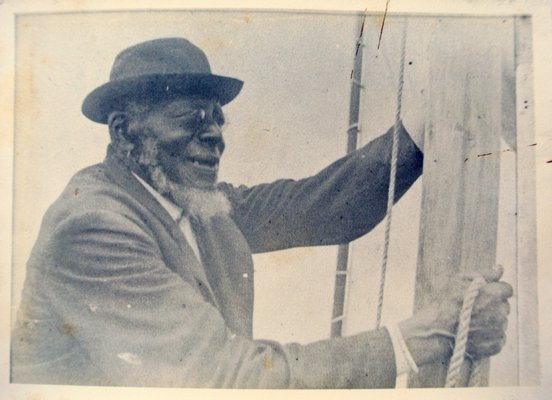
Pyrrhus Concer (March 17, 1814 - August 23, 1897)
Pyrrhus Concer (March 17, 1814 - August 23, 1897)
Pyrrhus Concer was born into slavery, in in Southampton, Long Island, NY. At the age of five he was separated from his mother and sold to Mr. Elias Pelletreau by Captain Nathan Cooper.
Around age 26 he was able to strike out on his own and after a brief stint as a farmhand shipped out on a whaling vessel, like many other Long Island men of the time. Whaling ships were one of the few places where Black men were treated as well (or badly) as the rest of the crew. By 1832 he had learned the ropes and became a pilot. In 1845, the whaleship Manhattan was serving on became famous in America for returning shipwrecked Japanese sailors back to their homeland, which at the time was a closed society, not open to foreigners. Back in Long Island starting with a house he inherited from his grandmother he acquired more property, and notably for a Black man of that era successfully maintained clear title to his land. Continuing his ties to the water, he operated a ferry on Lake Agawam near where he lived and became one of the most respected members of the village.
Elihu Root, Concer’s neighbor, Nobel prize winner and President Theodore Roosevelt’s secretary of state wrote Concer’s epitaph: “Though born a slave, he possessed those virtues, without which kings are but slaves.”
Sources:
“Pyrrhus Concer, A Life Of Significance,” Southampton African American Museum
“Endangered Historic Places 2021: Pyrrhus Concer Home Site,” Preservation Long Island
“Preservation Update: The Case Of The Pyrrhus Concer Homestead,” by Dr. Georgette Grier-Key, Long Island History Journal, 2016
“Archaeological Investigation Of The Pyrrhus Concer Homelot,” by Dr. Allison McGovern, 2017 (PDF)
“Pyrrhus Concer Homestead Now Southampton Historical Landmark,” by David Taylor, Behind the Hedges, February 5, 2021
“A Hamptons Property Fight Over a Black Whaler’s Homestead,” by Lindsay Gellman, The New York Times, Nov. 1, 2022
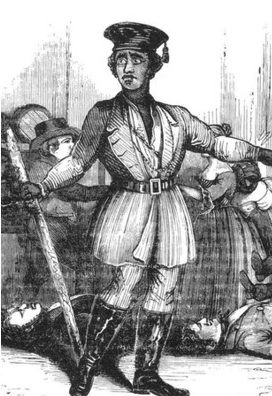
Richard Crafus (c.1791 – 1835)
Richard Crafus (c.1791 – 1835)
Richard Crafus was famous in his day, but his history is now unclear. He became a prominent African American leader, known as "King Dick" while imprisoned by the British during the War of 1812. An imposing man and boxer, it is said he was a privateer – a government approved pirate – captured by the British, as were many of the other Black men imprisoned with him. During the war of 1812, nearly 20% of the U.S. seamen were African Americans.
After the war historians think he returned to Boston and became a leader in the city’s African-American community.
Sources:
Alan Thomas Lipke, The Strange Life and Stranger Afterlife of King Dick including His Adventures in Haiti and Hollywood With Observations On The Construction Of Race, Class, Nationality, Gender, Slang Etymology and Religion. January 2013.
https://scholarcommons.usf.edu/cgi/viewcontent.cgi?referer=&httpsredir=1&article=5727&context=etd
New England Historical Society, "Richard Crafus, Black Captive King of the War of 1812," 2018. http://www.newenglandhistoricalsociety.com/richard-crafus-black-captive-king-war-1812/
Reginald Horsman, "The Paradox Of Dartmoor Prison," American Heritage. February 1975. https://www.americanheritage.com/paradox-dartmoor-prison
Stephen B. Luce Library, Black History Month 2015: Prolific African Americans in Maritime History, Society and Industry. February 11, 2015. https://www.slideshare.net/LuceLibrary/black-history-month-2015
Image source: http://www.newenglandhistoricalsociety.com/wp-content/uploads/2015/02/richard-crafus-portrait-2.jpg
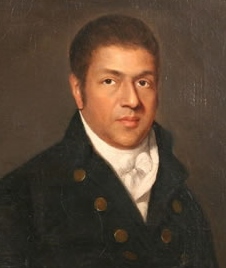
Paul Cuffe (1759-1817)
Paul Cuffe (1759-1817)
Paul Cuffe, the son of a freed slave and a Native American, went to sea as soon as he was old enough to leave home. During the American Revolution he served on a privateer and often participated in running American supplies through British blockades. At the end of the war, he and his brother-in-law opened a ship yard. With his ships he went on trading and whaling expeditions. By 1811 he was said to be the richest African American in the US and the largest employer of free African Americans. In 1839 he published Narrative of the Life and Adventures of Paul Cuffe, a Pequot Indian: During Thirty Years Spent at Sea
Sources
Paul Cuffe’s book on-line
https://archive.org/details/narrativeoflifea00cuff
BlackPast, “PAUL CUFFE SR. (1759-1817)”
http://www.blackpast.org/aah/cuffe-paul-sr-1759-1817
Britanica, “Paul Cuffe : American ship owner, merchant, and Pan-Africanist”
https://www.britannica.com/biography/Paul-Cuffe
PaulCuffe.org, “Paul Cuffe, a Brief Biography”
https://paulcuffe.org/biography
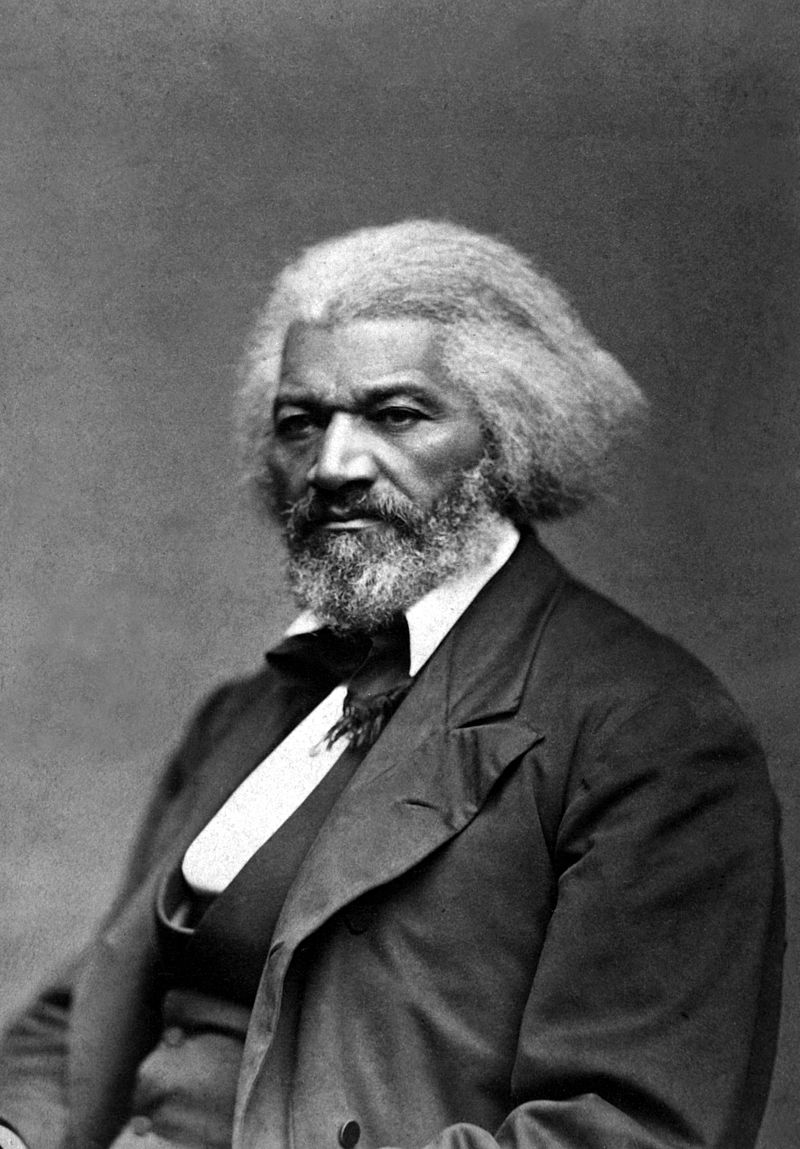
Frederick Douglass (1818-95)
Frederick Douglass (1818-95)
Frederick Douglass was an important African-American social reformer, abolitionist, orator, writer, and statesman. He escaped from slavery in Maryland by pretending to be a sailor. Trained to fix boats he borrowed the federal government issued Seaman’s Protection Certificate of a friend, and boarded a train to New York with the story that he was traveling to a job on a boat there. In his article My Escape from Slavery, he wrote "My knowledge of ships and sailor's talk came much to my assistance, for I knew a ship from stem to stern, and from keelson to cross-trees, and could talk sailor like an 'old salt.'"
Seaman’s Protection Certificates, were issued to American sailors of all races primarily to establish their citizenship when at sea or abroad, but they could offer a modicum of protection to Black sailors traveling between jobs in the US.
Sources:
Douglass, Frederick. "My Escape from Slavery." The Century Illustrated Magazine 23, n.s. 1 (Nov. 1881): 125-131. http://www.usc.edu:80/libraries/archives/ethnicstudies/historicdocs/douglass_articles.txt
Voyage to Discovery, “ Frederick Douglass” https://web.archive.org/web/20150416063416/http://voyagetodiscovery.org/douglass.htm
American Sailing, “Frederick Douglass: The Sailor You Should Know” by Zeke Quezada. https://asa.com
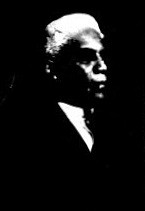
Henry Francis Downing (1846-1928)
Henry Francis Downing (1846-1928)
Henry Francis Downing was an author, playwright, consul and sailor. He was born in New York City in 1846, the son of Henry and Nancy Downing. His family maintained an oyster business that had been owned by his grandfather, Thomas Downing, a well-known freeman. In 1864 Henry Downing enlisted in the Union Navy at the Brooklyn Navy Yard.
After the Civil War, Downing began a journey around the world. He reached Liberia where his cousin, Hilary Johnson, would later become president of Liberia from 1884 to 1892. Downing lived in Liberia for three years where he was a private secretary to the secretary of state. Downing returned to the United States and in 1872, reenlisted in the Navy and served for three years. Most of his time was served on the U.S.S. Hartford which operated off the coast of East Africa. With considerable time spent in both West and East Africa, Downing was one of the African Americans most knowledgeable about the African continent and its politics
Sources:
BlackPast, “Henry Francis Downing (1846-1928)”
http://www.blackpast.org/aah/downing-henry-francis-1846-1928
Wikipedia “Henry Francis Downing”
https://en.wikipedia.org/wiki/Henry_Francis_Downing
Image Source: https://www.flickr.com/photos/puzzlemaster/4536784830

Thomas Downing (1791-1866)
Thomas Downing (1791-1866)
Thomas Downing, an African-American, amassed a fortune selling oysters during the 19th century. Upon his death, in 1866 at the age of 75, the New York Chamber of Commerce did something unheard of; it closed on a weekday so that its prestigious members could attend his funeral. Thomas Downing was born a free man to enslaved parents in Virginia, as a brief loophole in slavery laws allowed the Downing’s parents to gain their freedom. He learned about oysters raking them as a child on Chincoteague Island. He moved to NYC and introduced the idea of an upscale oyster house. At the time, oyster houses were rough places of ill repute, and Downing’s success had him serving NYC’s elite. Unbeknownst to them, he used the cellar as a stop on the underground railroad. He also used the fortune generated by the oyster house to fund schools for African American children, and he fought to desegregate NYC’s trolley system. His grandson Henry Francis Downing, continued running the oyster house and civil rights efforts in addition to careers as an author, playwright, consul, and sailor.
Sources:
“Downing's Oyster House,” Mapping the African American Past.
“How A Child of Virginia Slaves Became the Oyster King Of New York — And A Favorite of The Queen of England”. The Virginian-Pilot, Feb 15, 2020 by Matthew Korfhage
“How Thomas Downing became the Black Oyster King of New York”, The Splendid Table, March 14, 2018 by Francis Lam.
“The Venerable Thomas Downing – Black Oyster King Of New York”, the oyster's my world, October 2014
“Thomas Downing, From Son of Slaves to Oyster King of New York City,” The Old Salt Blog, Feb. 22, 2020 by Rick Spilman
Petition: An award honoring Thomas Downing, by Rudy Keefer
Song: “Downings Oyster Bar,” from The Oyster Aristocracy by Bob Wright and Harbortown
ALSO SEE: Freestyle Drive with Moody, the owner of Mother Shuckers, an Oyster Cart Business in Brooklyn, NY., Lebanese Ether, YouTube, December 1, 2020.

Olaudah Equiano c. 1745-1797
Olaudah Equiano c. 1745-1797
At the age of 11, Olaudah Equiano was kidnapped from Nigeria and sold to a sea captain in 1756. He became a skilled member of a ship's crew. Equiano was sold to a Quaker merchant from Philadelphia who allowed him to purchase his freedom in 1766. He is thought to be the author of the first Black slave narrative, The Interesting Narrative of the Life of Olaudah Equiano, or Gustavus Vassa the African (1789) a strongly abolitionist autobiography. The book became a bestseller and, as well as furthering the anti-slavery cause, made Equiano a wealthy man.
Sources:
Africans in America - WGBH, “Olaudah Equiano”
http://www.pbs.org/wgbh/aia/part1/1p276.html
Brycchan Carey, brycchancarey.com “Olaudah Equiano, or, Gustavus Vassa, the African” http://www.brycchancarey.com/equiano/
Voyage to Discovery, “Olaudah Equiano”
https://web.archive.org/web/20160315151514/http://www.voyagetodiscovery.org/equiano.htm
Wikipedia, “Olaudah Equiano”
https://en.wikipedia.org/wiki/Olaudah_Equiano
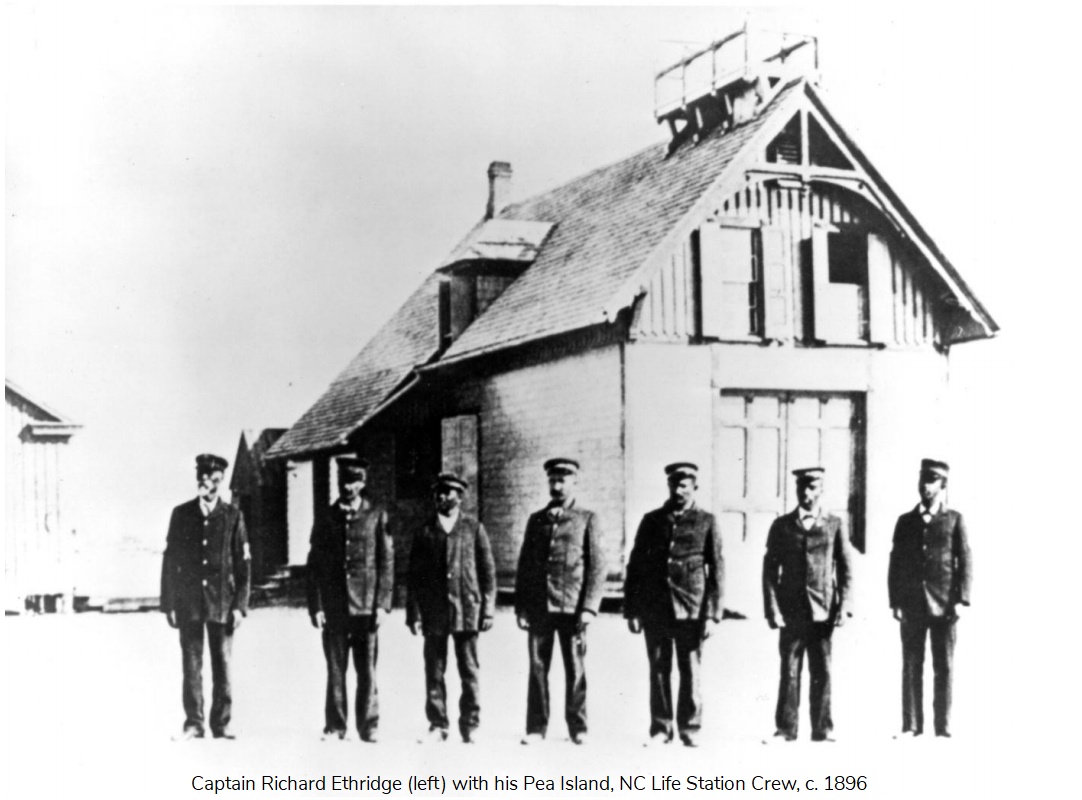
Captain Richard Etheridge (1842 -1900)
Captain Richard Etheridge (1842 -1900)
Captain Richard Etheridge, born a slave in North Carolina, joined the Union army during the US Civil War. Later, he entered the United States Life Saving Service (USLSS). By dint of his dedication and skill, in 1880, he was promoted to captain the Life-Saving station off the coast of Pea Island, North Carolina, becoming the first African-American to command such a position. Together with his all African-American crew, he rescued the lives of sailors in peril. In 1996, he and his team were posthumously awarded Gold Lifesaving Medals by the Coast Guard for the daring rescue of the crew of the three-masted schooner, the E.S. Newman that went aground in a terrific storm one hundred years earlier.
The USLSS, founded in 1848 to save the lives of the shipwrecked, merged with the Revenue Cutter Service in 1915 to form the US Coast Guard.
Sources:
Rescue Men: The Story of the Pea Island Life Savers (website for film by Allan R. Smith) http://www.rescuemenfilm.com/The_Story.html [accessed 2019]
Stephen B. Luce Library, Black History Month 2015: Prolific African Americans in Maritime History, Society and Industry. February 11, 2015. https://www.slideshare.net/LuceLibrary/black-history-month-2015
University of North Carolina at Chapel Hill Library, "Richard Etheridge Statue, Manteo," Commemorative Landscapes of North Carolina. https://docsouth.unc.edu/commland/ [accessed 2019]
U.S. Coast Guard, Captain Richard Etheridge, Keeper, USLSS, https://www.history.uscg.mil/Portals/1/personnel/pdf/Richard_Etheridge.pdf [source of image of Captain Etheridge and his crew]
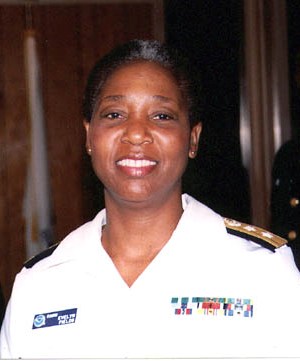
Rear Admiral Evelyn Fields (1949 - )
Rear Admiral Evelyn Fields (1949 - )
Evelyn J. Fields was the first African American rear admiral of the National Oceanic and Atmospheric Administration Commissioned Officer Corps. She served in that positon from 1999 to her retirement in 2003. She joined the NOAA Commissioned Corps in 1973 not looking to be a pioneer but just for an interesting occupational challenge after working as a civilian cartographer in the agency. "I think the highest praise you could give her is 'getting the job done,' " said Michael Henderson, a retired NOAA commander.
Denise Watson, “Norfolk's Evelyn J. Fields: Innovator for NOAA's research fleet”, The Virginian-Pilot, , February 5 2008. https://pilotonline.com/guides/african-american-today/article_24158fba-2224-53e6-8276-a9b271edd726.html
“Rear Admiral Evelyn Fields,“ Voyage to Discovery, (archived 2016) https://web.archive.org/web/20160414003636/http://www.voyagetodiscovery.org/fields.htm
“Evelyn J Fields”, Wikipedia, https://en.wikipedia.org/wiki/Evelyn_J._Fields
https://celebrating200years.noaa.gov/transformations/corps/side.html

Benjamin Harrison Fletcher (1890-1949)
Benjamin Harrison Fletcher (1890-1949)
Benjamin Fletcher, born in Philadelphia, as a longshoreman, loading and unloading cargo ships, joined the union, Industrial Workers of the World (IWW) and the Socialist Party in 1912. The IWW, known as the Wobblies, believed that all workers should unite as a class regardless of ethnicity or country of origin with the end goal of overthrowing the capitalist system. Fletcher became a popular speaker in the union and a prominent leader in Local 8 of the IWW, which was organized in 1913. Local 8 was unusual in its day for having integrated work gangs, leadership and gatherings. Its membership included African Americans, West Indians, European Americans, and European immigrants.
The federal government, targeted Fletcher and IWW leaders because of their stand against the war. Fletcher was one of 100s of IWW members who were convicted of treason in 1922. Fletcher served 3 years in prison before his sentence was commuted in 1922. His release became a celebrated cause among Black radicals. He died in Brooklyn in 1949.
Sources:
Cole, P. Benjamin Harrison Fletcher (1890-1949). BlackPast.org 2009. https://www.blackpast.org/african-american-history/fletcher-benjamin-harrison-1890-1949 (accessed 10/2021)
Encyclopedia.com, “Benjamin Fletcher” https://www.encyclopedia.com/african-american-focus/news-wires-white-papers-and-books/fletcher-benjamin (accessed 10/2021)
Conatz, Juan, “Ben Fletcher: Portrait of a Black Syndicalist” libcom.org, 2014 https://libcom.org/history/ben-fletcher-portrait-black-syndicalist (accessed 10/2021)

James Forten (1766-1842)
James Forten (1766-1842)
James Forten was born a freeman in Philadelphia, the grandson of slaves and the son of Thomas Forten, a sailmaker. . At the age of 8 he began working at a sail loft, making sails.
During the Revolutionary War Forten as boy of 12 served on the privateer Royal Louis. The ship was captured by the British but Forten was allowed to go back to work at the sail loft.
32 years later he owed the business with nearly 40 employees.He developed a sail better for maneuvering and maintaining greater speeds and amassed a fortune.With his wealth, he purchased slaves freedom, helped to finance and bring in funding for William Garrison's newspaper, the Libertarian, opened his home on Lombard Street as an Underground Railroad depot and opened a school for Black children.
https://web.archive.org/web/20160324135251/http://voyagetodiscovery.org/forten.htm

Charles Jackson French (1919 – 1956)
Charles Jackson French (1919 – 1956)
With a rope around his stomach, United States Navy Petty Officer First Class Charles Jackson French, swam for hours through shark infested waters, towing a raft of survivors of the sunken USS Gregory away from Japanese fire to safety on the shores of the Solomon Islands during WWII. The Seattle newspaper, The Northwest Enterprise, reported February 5, 1943, that the NAACP sought an award for Charles Jackson French. “French Receives Citation for Bravery” was a headline in his hometown paper, The Omaha Guide (member of the Associated Negro Press), May 22, 1943. According to that paper the citation was from Admiral William F. Halsey, Jr., USN., Commander, South Pacific Area and South Pacific Force, and reads in part: “For meritorious conduct in action while serving on board a destroyer transport which was badly damaged during the engagement with Japanese forces in the British Solomon Islands on September 5, 1942. After the engagement, a group of about fifteen men were a drift on a raft which was being deliberately shelled by Japanese naval forces. French tied a line to himself and swam for more than two hours without rest, thus attempting to tow the raft. His conduct was in keeping with the highest traditions of the Naval Service." An article in the same paper, Nov 7, 1942, reported that the raft held 25 men and he swam for 6 hours. The Michigan Chronicle, December 5, 1942, reported that French was reunited with a fellow shipmate on a nationwide NBC radio program celebrating his “6 hour swim through shark infested waters.” An editorial printed in the November 21, 1942 edition of the Jackson Advocate decried the reluctance of the white press to properly credit acts of heroism and bravery by Black men such as Dorrie Miller and Charles Jackson French. Efforts for French to receive more than a letter but a medal for his actions continue to the present.
Sources:
Black Lifesavers of WWII by Bruce Wigo, International Swimming Hall of Fame 2016 (pdf)
Black Swimming History: A World War II Hero. Swimming World Magazine
Charles Jackson French, Wikipedia
How Charles French swam eight hours in shark waters to save 15 U.S sailors in WWII, by Michael Eli Dokosi, Face2FaceAfrica.com.
The Story of Charles Jackson French, by Bruce Wigo, ishof.org (pdf)
Weaquatics (Facebook post)
The Omaha Guide. Nov. 7, 1942 & May 22, 1943.
Jackson Advocate. (Jackson, Miss.), Nov. 21, 1942.
The Michigan Chronicle. (Detroit), Dec. 5, 1942.
The Northwest Enterprise. (Seattle, Wash.), Feb. 5, 1943.
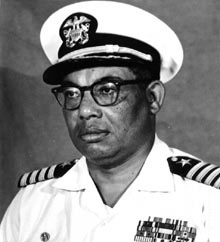
Samuel Lee Gravely (1922-2004)
Samuel Lee Gravely (1922-2004)
Samuel Lee Gravely Jr. was a highly decorated Navy Officer who pioneered the way with a multitude of firsts for African Americans in the military. Some of his most notable achievements included, being the first African American Navy Vice Admiral, the first African American to command a Navy warship, the first African American to command a warship during combat, the first African American to command a Navy Fleet, and the first African American to obtain Flag Rank in the military. His decorations include the Bronze Star, Legion of Merit, Navy Commendation Medal, and Meritorious Service Medal.
Sources:
Ryan Hurst, “Samuel Lee Gravely (1922-2004) Black Past. www.blackpast.org/aah/gravely-samuel-lee-1922-2004
Regina T. Akers, Naval History Blog, “Vice Adm. Samuel L. Gravely, Jr., USN: Naval Officer, Trailblazer.” January 31, 2004. https://www.navalhistory.org/2014/01/31/vice-adm-samuel-l-gravely-jr-usn-naval-officer-trailblazer-prepared-by-regina-t-akers-ph-d-historian-naval-history-and-heritage-command
The Washington Post, “Samuel Lee Gravely JR., 82” Chicago Tribune, October 25, 2004. https://www.chicagotribune.com/news/ct-xpm-2004-10-25-0410250014-story.html
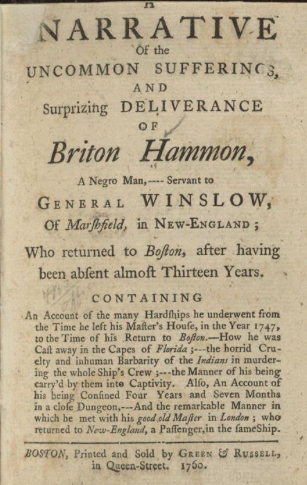
Briton Hammon (c. 1720s-after 1776)
Briton Hammon (c. 1720s-after 1776)
A Narrative of the Uncommon Sufferings, and Surprising Deliverance of Briton Hammon, A Negro Man,… first printed in 1760, is the first published narrative by an African American. In it Hammon tells of his almost thirteen years of adventures at sea, much of it not of his own choosing. According to the account, Hammon, an enslaved man, working for General Winslow of Massachusetts, sailed to Jamaica in 1747. On the return trip back, his ship runs aground off the coast of Florida and he is captured an indigenous group. Next, he is sold to a Spanish captain then sold to the Governor of Cuba. Refusing to serve in a Spanish royal ship, he serves almost 5 years in jail, before being freed by the governor. Hammon escapes Cuba by getting aboard a British vessel and joining the crew. In a battle with the French, he is hurt , released of his duties, and sent to London to recover. Needing work, he joins a ship setting sail to Massachusetts, only to find on board General Winslow. Their reunion is described as a happy accident.
Scholars see in Hammon’s narrative a careful criticism of slavery in New England, in the way he describes how his liberty was robbed by the Spanish while saying that he was treated well. The account also provides a glimpse into what life was like as Black sailor in late 1700s.
Sources:
A Narrative Of The Uncommon Sufferings, And Surprizing Deliverance Of Briton Hammon, A Negro Man,--Servant To General Winslow …, by Britton Hammon, 1760. Transcribed copy at Documenting the American South.
“Briton Hammon,” BIMAAR: Black Inter-American Mobilities and Autobiography in the Age of Revolutions.
“Briton Hammon.” By Bradley, Jonathan. BlackPast.org, December 2020.
“Briton Hammon, Narrative of the Uncommon Sufferings” Early Visions of Florida
“Briton Hammon,” Wikipedia.
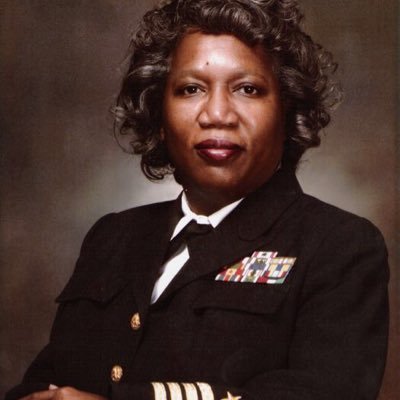
Captain Gail Harris
Captain Gail Harris
Captain Gail Harris an African American woman whose career in the Navy was one of "firsts," notably, in 1973, she was the first African-American woman to serve as a Naval Intelligence Officer. When she retired in 2001, Harris was the highest-ranking African-American woman in the Navy. Her resume includes instructing at the Armed Forces Air Intelligence Training Center and heading the Pentagon's intelligence, support for the 1988 Seoul Olympics. Her memoir, A Woman's War, was published in 2010.
Sources:
Gail Harris, "GailForce," Foreign Policy Association blog. https://foreignpolicyblogs.com/author/gailharris/
Stephen B. Luce Library, Black History Month 2015: Prolific African Americans in Maritime History, Society and Industry. February 11, 2015. https://www.slideshare.net/LuceLibrary/black-history-month-2015
Wikipedia contributors, "Gail Harris (naval officer)," Wikipedia, The Free Encyclopedia, https://en.wikipedia.org/w/index.php?title=Gail_Harris_(naval_officer)&oldid=858809962 (accessed February 21, 2019).
Captain of Persistence: Gail Harris http://gailharrisspeaker.com/gail_bio.html
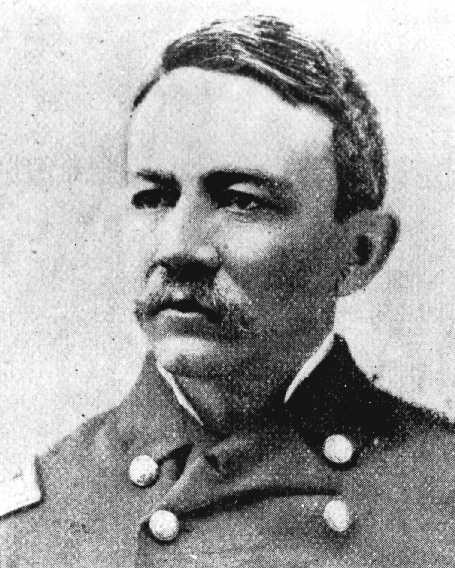
Michael Augustine Healy (1839 - 1904)
Michael Augustine Healy (1839 - 1904)
Michael Healy was a career officer with the United States Revenue Cutter Service. His father was a Irish immigrant planter who owned Healy’s mother and lived with her as his wife, and their children passed as white. Healy is honored as the first Black officer in what became the Coast Guard (USCG) and has a USCG icebreaker named after him, their largest vessel.
Sources:
BlackPast, “Michael Augustine Healy”
http://www.blackpast.org/aaw/healy-michael-augustine-1839-1904
James M. O'Toole, “Racial Identity and the Case of Captain Michael Healy, USRCS”
https://www.archives.gov/publications/prologue/1997/fall/michael-a-healy-1.html
Ocean Explorer - NOAA, “Captain ‘Hell Roaring’ Mike Healy—Tamer of America’s Western Sea Frontier”
https://oceanexplorer.noaa.gov/explorations/19bear/background/healy/healy.html
We’re History, “Hiding in Plain Sight: Hell-Roaring Mike” http://werehistory.org/mike-healy
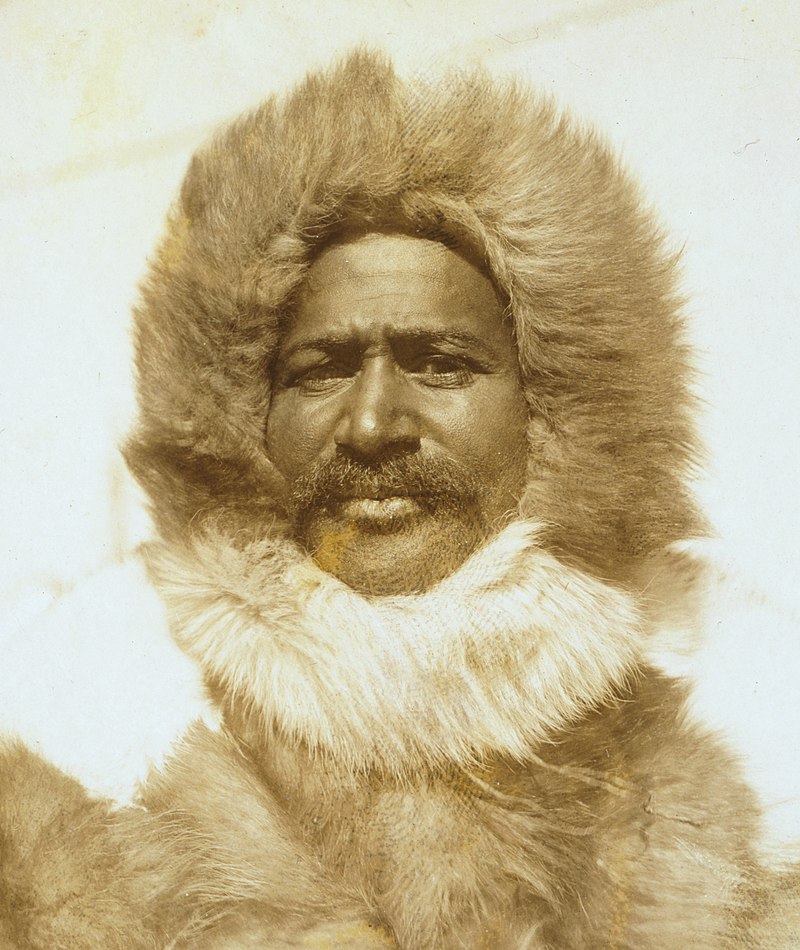
Matthew A. Henson (1866 – 1955)
Matthew A. Henson (1866 – 1955)
Matthew A. Henson, at the age of 11 or 12, left Baltimore as a cabin boy aboard a ship. He soon sailed to the Baltic Sea where bitter cold locked the ship in ice for several months. Far from putting him off, he would become the first African American explorer in the Artic, and, in 1909, may have been the first to reach the North Pole, slightly before his more famous mentor and fellow explorer Robert E. Perry.
Sources:
Digital and audio versions of his book: A Negro Explorer at the North Pole, are available on line:
Matthew Alexander Henson, A Negro Explorer At the North Pole. New York: Frederick A. Stokes company, 1912.
LibriVox audio book: https://archive.org/details/negro_explorer_north_pole_ls_1412_librivox
Digital copy: https://archive.org/details/negroexploreratn00hens/page/n19
African American Registry, Explorer from the heart, Matthew Henson
https://aaregistry.org/story/explorer-from-the-heart-matthew-henson/ [accessed 2019]
Brian Clark Howard, "Historic Photos Celebrate Pioneering Black Explorer." National Geographic website: https://news.nationalgeographic.com/2016/02/160224-polar-explorer-matthew-henson-photos/ [accessed 2019]
Cheryl Lederle, "Polar Explorer Matthew Henson and the Blizzard of Fame," Teaching with the Library of Congress. February 20, 2018. https://blogs.loc.gov/teachers/2018/02/polar-explorer-matthew-henson-and-the-blizzard-of-fame/ [accessed 2019]
The Robinson Library, Matthew Henson: the first man to reach the North Pole, http://www.robinsonlibrary.com/geography/geography/arctic/henson.htm [accessed 2019]
Stephen B. Luce Library, Black History Month 2015: Prolific African Americans in Maritime History, Society and Industry. February 11, 2015. https://www.slideshare.net/LuceLibrary/black-history-month-2015

Olivia Hooker (1912 -2018)
Olivia Hooker (1912 -2018)
In 1945, Olivia Hooker became the first African American woman in the US Coast Guard. She served in the Coast Guard until her unit disbanded in mid-1946. She went on to be a psychologist and a professor at Fordham University. She retired at 87 and joined the Coast Guard Auxiliary at age 95. She was a survivor of the Tusla Massacre of 1921. She was a founder of the Tulsa Race Riot Commission and one of the survivors who filed an unsuccessful federal lawsuit seeking reparations in 2003.
Tulsa Girl, a children’s book by Shameen Ebony Anthanio-Williams (see her own entry on this list) tells Olivia’s story experiencing the Tulsa Race Riot as a young girl
Sources:
Google Doodle, Olivia J. Hooker (Coast Guard) - Veterans Day 2018. https://vimeo.com/300222346 (accessed February 2019).
Olivia Hooker speaks at a screening of the film Before They Die: A documentary about the Survivors of the 1921 Tulsa race massacre and their quest for justice. Vimeo video, 2010
President Obama, “The President Delivers the United States Coast Guard Academy Commencement Address” - At 26:46 to 29:52 President Obama speaks about Dr. Hooker. She, then 100 years old, was present. Youtube. 2015
US Coast Guard, “Dr. Olivia Hooker: A SPAR's Story,” Youtube, 2013 (Interview)
Wikipedia contributors, "Olivia Hooker," Wikipedia, The Free Encyclopedia, https://en.wikipedia.org/w/index.php?title=Olivia_Hooker&oldid=880893878 (accessed February 20, 2019).
LT Stephanie Young, “Olivia Hooker: A SPAR’s Story,” Coast Guard Compass, http://coastguard.dodlive.mil/2013/10/olivia-hooker-a-spars-story (accessed February 20, 2019)

John Mashow
John Mashow (1805 -1893) was a boat builder born to an enslaved woman and South Carolina rice planter father. He designed over 100 ships and supervised construction of over 60. About a third of these were whalers
He was freed by his father and sent to live in Massachusetts. Around 1818 he became apprenticed to Leban Thatcher as a shipbuilder. In 1845 he partnered with three other men to form the Mathews, Mashow & Company shipyard outside of New Bedford. The company lasted a little over ten years but some of their ships sailed into the next century, and likely more of them would have but for the South’s sinking of whalers during the Civil War.
Sources:
“From War Ships of the Past to Educational Beauties of Today,” by Skip Finley, Vinyard Gazette, July 7, 2016.
“John Mashow,” Organization of Black Maritime Graduates, obmg.org
“John Mashow: From Slavery to Master Shipbuilder and Designer,” by Skip Finley. New Bedford Historical Society, Sea History, vol 174, Spring 2021.
“Shipbuilder's Half Hull Model, Whaleship Jireh Swift,” Smithsonian, SI.edu
“Ships Built/Designed by John Mashow,” list compiled by Skip Finley

Rear Admiral Zeita Merchant, USCG
Rear Admiral Zeita Merchant, USCG
Update: April 22, 2024.
This entry was first written when Zeita Merchant was promoted to Captain of the Port for the NYC region. On April 22, 2024, in a ceremony held at the theater which is home of the musical Hamilton (Hamilton established the Coast Guard), Merchant was promoted to Rear Admiral becoming the highest ranking African American woman in the Coast Guard’s 234 years.
Captain Zeita Merchant became just the 3rd third Black woman in the history of the Coast Guard to achieve the rank of Captain, when she was promoted on July 1, 2020. In May of the following year she became the 2nd woman to lead US Coast Guard's Sector New York. aka Captain of the Port (COTP), and the 1st minority to do so. At the time she had 24 years of military experience with extensive education and training in national security and environmental issues.
Merchant was born on the west side of Chicago and grew up in Jackson, Mississippi after her family moved. A chance meeting with a USCG recruiter in college inspired her to sign up. Merchant started her Coast Guard career as a graduate of the first Officer Candidate School (OCS) class at the Coast Guard Academy. During her first tour in D.C., Merchant met Dr. Olivia Hooker (also featured on this page) the first African-American woman to enlist in the Coast Guard. With few Black women in the USCG, Dr. Hooker remained, until her death, an important mentor to Merchant.
Merchant graduated with honors from Tougaloo College with a BS in Biology (1998). Her additional degrees are: MS in Quality Systems Management from the National Graduate School of Quality Management (2004), MPA of Public Administration, Environmental and Emergency Management from George Washington University (2010), DBA of Business Administration from National Graduate School of Quality Management (2011). She has completed fellowships in national security and foreign policy at Harvard and MIT.
Sources:
PortSide NewYork’s Instagram post about Merchant’s promotion. with video clip of the ceremony. (Portside’s director was pleased to be in attendance.)
“Zeita Merchant becomes 1st Black female admiral in Coast Guard history,” PIX11 News, April 22, 2024
“Coast Guard Captain Zeita Merchant Keeps New Yorkers Safe While Blazing New Trails,” by Maurice DuBois, CBS New York, February 2, 2022
“Honor, Respect, Devotion to Duty: Cmdr. Zeita Merchant” Coast Guard Compass, September 2, 2016 & Friday, July 6, 2018 (two articles)
“Interviews: Commander Zeita Merchant, PhD” The Journal of the Trachtenberg School of Public Policy and Public Administration at The George Washington University, Volume 25, 2018
“Representation Matters: When I think about the little girls that may be looking and say, ‘Hey, can I ever do that?’ Yes you can.” Fleet Week New York, Facebook post, May 29, 2021. (Video)
US Coast Guard’s Facebook post, July 1, 2020

Raye Jean Montague (1935 – 2018)
Raye Jean Montague (1935 – 2018)
The first computer-generated rough draft of a U.S. naval ship was created by African American naval engineer Raye Jean Montague. She was the first female program manager of ships in the United States Navy. She credits here interest in engineering from seeing a midget submarine in traveling exhibit that came to her home town of Little Rock, Arkansas when she was a young girl: “My grandfather took me downtown to see that submarine and I was able to go down a little ladder into that sub. It was like a tin can. That was my first introduction to ships. You just never know what inspires a person.”
Montague joined the Navy as a clerk in 1956, There she watched watched a UNIVAC computer in use and one day when all the engineers were out sick she jumped in and showed she was quite capable of running it herself. Jobs more in keeping with abilities followed and she became the program director for the Naval Sea Systems Command’s Integrated Design, Manufacturing and Maintenance Program. In 1970, Montague recalled, “The admirals came to me and said, ‘Young lady, we understand you’ve got a system to design ships,' ‘The President has given us two months, we can give you a month, can you do it?” She did it just under 19 hours.
Sources:
Butler, Caitlan ."Rotary celebrates International Women's Day with discussion on Raye Montague, pioneering Navy engineer" Eldoradonews.com, March 8, 2021
"Engineer Raye Montague: The Navy's 'Hidden Figure'". blackdoctor.org. February 2, 2017.
Finley, Mosca J, and Daniel Rieley. The Girl with a Mind for Math: The Story of Raye Montague. Ashland: The Innovation Press, 2020
Raye Jean Jordan Montague (1935–2018), encyclopediaofarkansas.net
Raye Montague: The "Hidden Figure" Who Revolutionized Naval Ship Design, amightygirl.com, 2022
“Storytime with DMNH: The Girl With the Mind for Math,” Delaware Museum of Nature & Science. Youtube video.
Wikipedia, Raye Montague

Isaac Myers (1835-1891)
Isaac Myers (1835-1891)
Isaac Myers was born in Baltimore at a time when many American Blacks were enslaved, but both his parents were free. At the age of 16, he apprenticed as a ship caulker, making wooden boats watertight, and by age 20 he was leading the job on large clipper ships. In 1865, after more than 1,000 black longshoremen and mechanics lost their jobs because of their color, Myers joins with other business men to raise funds and open a color-blind shipyard. The company operates until 1884.
Myers had many other accomplishments including being key to the formation of the first national black labor union.
Sources:
Isaac Myers, The Baltimore Sun, February 12, 2007 https://www.baltimoresun.com/features/bal-blackhistory-myers-story.html
Isaac Myers: Pioneer of the African-American Trade Union Movement, APWU.org, January 2009
http://www.apwu.org/labor-history-articles/isaac-myers-pioneer-african-american-trade-union-movement
Isaac Myers (1835-1891), by Camille Heung Black Past, June 23, 2008
https://www.blackpast.org/african-american-history/myers-isaac-1835-1891/
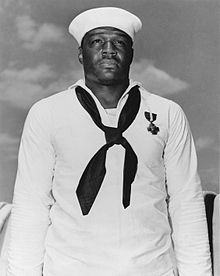
Doris "Dorie" Miller (1919-1943)
Doris "Dorie" Miller (1919-1943)
On December 7, 1941, Doris Miller, an African-American sailor aboard the USS West Virginia, went from serving as the ship’s cook to a war hero when the Japanese attacked Pearl Harbor.
Several movies include his story; Cuba Gooding Jr. portrays Miller in the 2001 Movie Pearl Harbor and Miller is shown being awarded the Navy cross in the 2019 film Midway.
In 2020 the US Navy let it be known that they are building a supercarier to be christened the USS Doris Miller. She will be first named for an enlisted sailor and the first to be named after an African American.
Sources:
BlackPast. “Doris Miller”
http://www.blackpast.org/aah/miller-doris-dorie-1919-1943
NPR.org, “A Military 1st: A Supercarrier Is Named After An African American Sailor” (includes radio audio) https://www.npr.org/2020/09/29/917816651/a-military-first-a-supercarrier-is-named-after-an-african-american-sailor
Voyage to Discovery, “"Dorie" Miller” https://web.archive.org/web/20160413215736/http://www.voyagetodiscovery.org/miller.htm
Wikipedia, “Doris Miller”
https://en.wikipedia.org/wiki/Doris_Miller
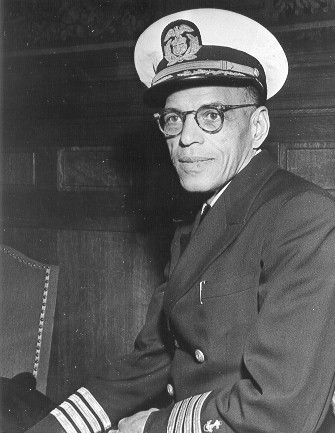
Captain Hugh Mulzac (1886-1971)
Captain Hugh Mulzac (1886-1971)
In 1942 at the age of 56, Hugh Mulzac became the first African-American merchant marine naval officer to skipper an integrated crew. More than two decades earlier, Captain Mulzac had declined command of a ship with an all-Black crew saying "under no circumstances will I command a Jim Crow vessel."
With Mulzac at the helm, the Liberty Ship SS Booker T. Washington made 22 round-trip voyages in five years carrying 18,000 troops to Europe and the Pacific.
Sources:
gCaptain, “Captain Mulzac WW2 Hero and America’s First Black Master Mariner”
https://gcaptain.com/mulzac-first-black-master-mariner/
MARAD Maritime Administration, “The First African-American Shipmaster: Captain Hugh Mulzac”
https://www.maritime.dot.gov/k-12/salute-african-american-mariners/first-african-american-shipmaster
WNYC - NEH Preservation Project, “Hugh Mulzac: Captain, Victim, Survivor” (Includes radio audio)
https://www.wnyc.org/story/hugh-mulzac-captain-victim-survivor/
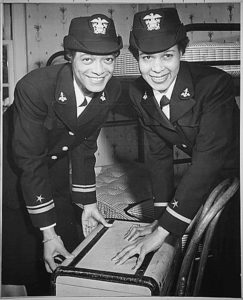
LT Harriet Ida Pickens and ENS Frances Eliza Willis, WWII
LT Harriet Ida Pickens and ENS Frances Eliza Willis, WWII
LT Harriet Ida Pickens and ENS Frances Eliza Willis Graduates became the first African-American women commissioned into the U.S. Navy when they became WAVES (Women Accepted for Volunteer Emergency Service) in 1944. More than 70 otherBlack women followed their lead by September 2 1945.
Francis Willis Thorpe wrote about her experiences in her 2007 book, Navy Blue and Other Colors: A Memoir of Adventure and Happiness.
Sources:
Regina Akers, Ph.D, "Remembering the First Black Women Naval Officers" The Sextant, October 17 2014. http://usnhistory.navylive.dodlive.mil/2014/10/17/remembering-the-first-black-woman-naval-officers/ [accessed 2019]
Stephen B. Luce Library, Black History Month 2015: Prolific African Americans in Maritime History, Society and Industry. February 11, 2015. https://www.slideshare.net/LuceLibrary/black-history-month-2015
Andrew Zimmerman, Courage in Adversity: Harriet Pickens & Frances Wills. Aug 30, 2017 https://womenoffshore.org/courage-in-adversity-harriet-pickens-frances-wills/ [accessed 2019]

William "Bill" Pinkney (1935-August 31, 2023 )
William "Bill" Pinkney (1935-August 31, 2023 )
In 2021, Captain Bill Pinkney received a well-deserved award from the National Sailing Hall of Fame, a "Lifetime Achievement Award – Enthusiastic Trend Setter." His list of accomplishments is HUGE. He was the first captain of the replica AMISTAD (which visited PortSide) now run by Discovering Amistad.
Before that, Pinkney was the first Black sailor to solo circumnavigate the globe. In addition to that sailing feat, we really admire him for his dedication to educating and inspiring youth, especially Black youth like him who did not see themselves sailing. He made his circumnavigation an educational event - in the early 1990s, well before people were blogging from sea. Over 1,000 students greeted him on the dock as he finished his circumnavigation
The National Sailing Hall of Fame noted that his "27,000 mile circumnavigation took 22 months and ended on June 9, 1992. Throughout the trip Pinkney sent footage back to Globe TV and communicated with some 30,000 school children. The finished production titled, The Incredible Voyage of Bill Pinkney, won the George Foster Peabody Award for excellence in children’s television programming. The film has aired on the Disney Channel, National Geographic and PBS stations. He was in high demand as a public speaker. His book, “Captain Bill Pinkney’s Journey” was used for learning to read, and for teaching the lessons of commitment and reaching goals. His talks, book and film have inspired thousands of sailors of all ages."
Pinkney published his second children’s book in 2022 after raising funds with GoFundMe appeal: Sailing Commitment Around the World with Bill Pinkney. In 2023, Bill Pinkney died at the age of 87. the result of a fall. Pinkney chose the Jewish faith at the age of 12 and formerly converted after becoming engaged to his second wife, Ina Pinkney. he maintained his faith throughout his life.
Sources:
“Lessons from Bill Pinkney’s Historic Solo Sail Around the World,” PBS News hour.
https://www.pbs.org/newshour/show/lessons-from-bill-pinkneys-historic-solo-sail-around-the-world
National Sailing Hall of Fame:
https://nshof.org/inductees/pinkney-william
BlackPast.org
https://www.blackpast.org/african-american-history/pinkney-william-bill-1935/
Black Chicago Sailors
http://blackchicagosailors.org/captainbillpinkn.html
The History Makers
https://www.thehistorymakers.org/biography/capt-william-bill-pinkney-39
The New York Times. “Sailor Makes Solo Voyage Around Globe”, https://www.nytimes.com/1992/06/10/us/sailor-makes-solo-voyage-around-globe.html
“Captain William Pinkney Around The World Alone (Part II)”, Atlantic Creole: Black Folk Don't Sail XXXVII [Source of image]
http://herossea.blogspot.com/2014/05/atlantic-creole-black-folk-dont-sail_29.html
“Jewish sailor Bill Pinkney, first Black person to circle the globe solo, dies at 87,” The Times of Israel, September 6, 2023.

Venture Smith (c. 1729 – 1805)
Venture Smith (c. 1729 – 1805)
Venture Smith was one of nearly 12 million Africans who came to America as a captive, but one of very few who wrote a first-hand account of his experiences: A Narrative of the Life and Adventures of Venture, a Native of Africa: But Resident above Sixty Years in the United States of America. Related by Himself, published in 1798. Smith was able to buy his freedom and returned to the sea for a time as a sailor on a whaling expedition.
Sources
The National Humanities Center “Venture Smith (Broteer Furro) Describes His West African Homeland & His Capture” (PDF)
http://nationalhumanitiescenter.org/pds/maai/freedom/text3/furro.pdf
County Times, “Larger-Than-Life Former Slave Lives On in Project” February 3, 2011
http://www.countytimes.com/news/larger-than-life-former-slave-lives-on-in-project/article_bcd7beb5-4223-59b6-8bbd-8e00ecb0641d.html
Culture24, “The Life of Venture Smith: Hull reveals the remarkable story of a self-freed slave” August 23, 2011
http://www.culture24.org.uk/history-and-heritage/art362727
Conneticut History.org, “Venture Smith, from Slavery to Freedom” February 16, 2015
https://connecticuthistory.org/venture-smith-from-slavery-to-freedom
PBS - Learning Media, “The Life of Venture Smith” (video) https://ny.pbslearningmedia.org/resource/adlit08.ush.col.smith/the-life-of-venture-smith/#.Wl0darynFlY
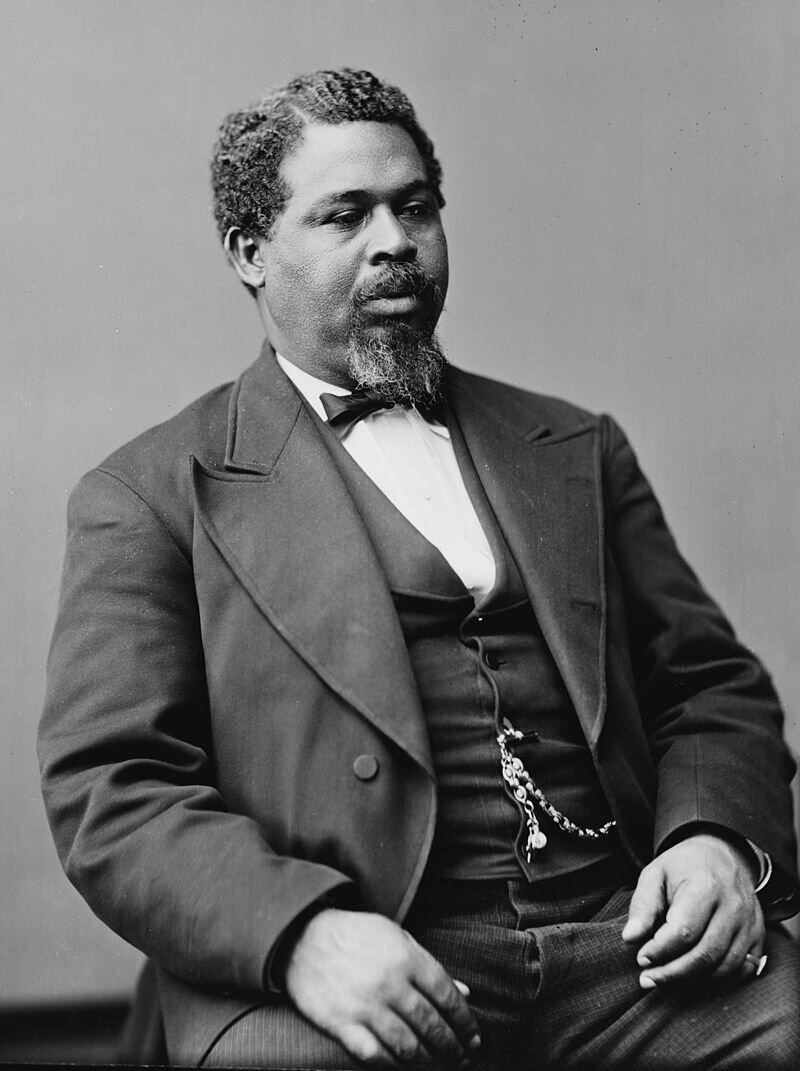
Robert Smalls (1839 - 1915)
Robert Smalls (1839 - 1915)
Robert Smalls, 22 years old, was working as a slave on a Confederate military supply boat, the PLANTER in Charleston Harbor, South Carolina at the outset of the Civil War. On May 12, 1862, Smalls commandeered the ship, faked being the captain, sounded pass codes to get past two forts, and steered by three more on an over 7 miles trip to freedom. On his way out of the harbor, he stopped the PLANTER to pick up the families of the rest of the enslaved Black crew. Arriving at the open sea he surrendered the fully loaded PLANTER, along with valuable military info, to Northern forces. Enraged Confederates put a bounty on his head, but in the North, he became a celebrity, giving public speeches in NYC and elsewhere.
In October of 1862, Smalls returned to the PLANTER as pilot and was involved in 17 military actions including the assault on Fort Sumter. Smalls was promoted to Captain, and starting in December 1863, earning $150 a month, making him one of the highest paid Black soldiers of the Civil War.
After the war, he returns to South Carolina, and becomes the 1st Black man elected to the State Assembly. There he writes the legislation that leads to the 1st free compulsory public schools in South Carolina – the first in the US. Smalls was also the 1st Black man elected to Congress, serving 5 nonconsecutive terms, 1874-1886. (In 1885 his state revised their constitution effectively stripping Blacks of their Voting rights.)
Smalls was also involved in transportation: he led a mass boycott of segregated public transportation in Charleston and he formed with partners the Enterprise Railroad, an 18-mile horse-drawn railway that moved people and goods between Charleston harbor and inland depots. It’s board of directors was entirely Black except for one.
February 2023, the US Navy announced that it would be renaming one of their guided-missile cruisers to honor Robert Smalls. The vessel was one of two ships identified by a commission tasked with purging Confederate names from the Department of Defense. The ship's current name, Chancellorsville (CG-62), memorializes a battle won by the Confederate South that resulted in the death of their General “Stonewall” Jackson. Secretary of the Navy Carlos Del Toro said in a statement.
“The renaming of these assets is not about rewriting history, but to remove the focus on the parts of our history that don’t align with the tenets of this country, and instead allows us to highlight the events and people in history who may have been overlooked.”
The renamed ship, however, is scheduled to be decommissioned in 2026.
This is an abridged version of PortSide’s AfricanAmerican MiniHistory on Robert Smalls. (This PDF prints on 6 double-sided pages to make a 12 page booklet.)
Sources: (some of many)
Henry Louis Gates, Jr, “Which Slave Sailed Himself to Freedom? “ https://www.pbs.org/wnet/african-americans-many-rivers-to-cross/history/which-slave-sailed-himself-to-freedom
History, Art & Archives, U.S. House of Representatives, “SMALLS, Robert,” https://history.house.gov/People/Listing/S/SMALLS,-Robert-(S000502)/ (October 06, 2021)
Helen Boulware-Moore, "The Life and Times of Congressman Robert Smalls," A Traveling Exhibition (archived website). [The Boulware-Moore are descendants of Robert Smalls.] https://web.archive.org/web/20160305003017/http://www.robertsmalls.com/index.html.
See also: “The Descendants: Robert Smalls' great-great grandson says he's the unsung hero of the Civil War,” The Grio.com, February 21, 2013. https://thegrio.com/2013/02/21/the-descendants-robert-smalls-great-great-grandson-says-hes-the-unsung-hero-of-the-civil-war
Michael Boulware Moore, “The Audacity of Robert Smalls” TEDx talk by his great grandson https://www.youtube.com/watch?v=w6T7ksyhUkw
NOAA..“NOAA identifies probable location of iconic Civil War-era steamer: Former slave piloted Planter to freedom,” NOAA, National Marine Sanctuaries press release 5/14/2014. https://sanctuaries.noaa.gov/news/press/2014/pr051314.html
P.K Rose. “Black Dispatches: Black American Contributions to Union Intelligence During the Civil War” Reprint of article from Studies In Intelligence, a journal published by CIA's Center for the Study of Intelligence. https://web.archive.org/web/20160924025142/https://www.cia.gov/library/center-for-the-study-of-intelligence/csi-publications/books-and-monographs/black-dispatches
Bruce G. Terrell, Gordon P. Watts & Timothy J. Runyan, “The Search for PLANTER: The Ship that Escaped Charleston and Carried Robert Smalls to Destiny”. NOAA Maritime Heritage Series No. 1, 2014. (PDF) http://npshistory.com/publications/noaa/search-for-planter.pdf
“USS Chancellorsville to be Renamed After Former Slave Who Captured Confederate Ship,” by Sam LaGrone, February 27, 2023, USNI News.
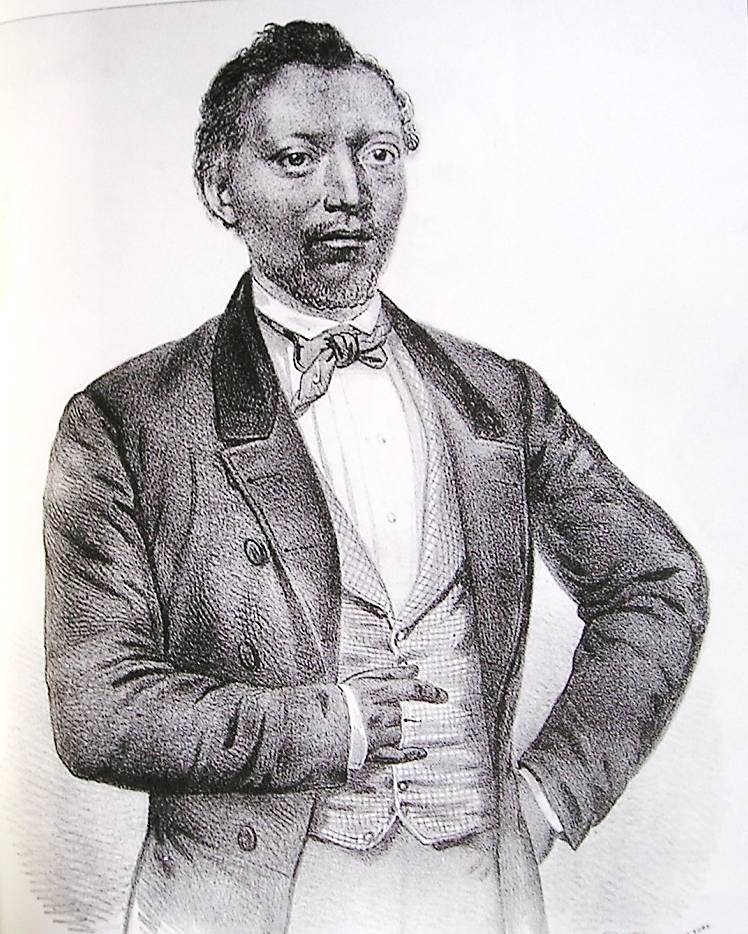
William Tillman (b. 1834)
William Tillman (b. 1834)
William Tillman was a steward and cook on-board the merchant schooner S.J. Waring a few months into the American Civil War when his the ship was captured by Confederate privateers. They declared the ship and William Tillman, their property and proceed to sail the ship from the waters off of New Jersey to the South. Fifty miles off Charleston, South Carolina, Tillman overpowers the privateers, recaptures the ship and sails it back to New York where he is rewarded and celebrated.
Sources:
Black Past, “William Tillman”
http://www.blackpast.org/aah/tillman-william-b-k-william-tilghman-1834-1880
US Maritime Administration, “A Story of High Seas Heroism: The Story of William Tillman”
https://www.maritime.dot.gov/k-12/salute-african-american-mariners/story-high-seas-heroism-0
The New York Times, “The Lion of the Day”
https://opinionator.blogs.nytimes.com/2011/08/04/the-lion-of-the-day/
Rick Spillman’s OLD SALT blogpost: http://www.oldsaltblog.com/2020/02/black-history-month-william-tillman-and-the-privateer-jefferson-davis/

Dr. Gladys West (b. 1931)
Dr. Gladys West (b. 1931)
Gladys West was part of the team that developed the Global Positioning System in the 1950s and 1960s. In 1956 she was hired as a mathematician by the Naval Surface Warfare Center, Dahlgren Division. There she learned how to program and code an early computer. Her refined scientific calculations from satellite data led to an extremely accurate mathematical model of the Earth, which in turn became the basis of today’s Global Positioning System (GPS).
West later worked for NASA's Jet Propulsion Laboratory as the program manager for SEASAT, the first satellite designed to collect data on ocean surface winds, temperatures, waves, ice and topography.
Sources:
“100 Women: Gladys West - the 'hidden figure' of GPS,” By Amelia Butterly, BBC News, May 19, 2018
“Gladys West, 2021 NCWIT Pioneer in Tech Award Recipient” The National Center for Women & Information Technology
“Here's one of the people to thank for your GPS” By Cathy Dyson, Military Times, February 13, 2018
“Meet Dr. Gladys West, the hidden figure behind your phone’s GPS,” By Lauren Mackenzie Reynolds, Massive Science, December 25, 2019
“Navy Hidden Hero: Gladys Mae West and GPS” U.S. Navy. YouTube, December 19, 2018.
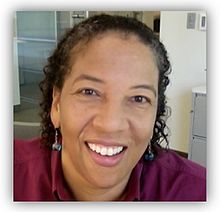
Dawn Wright
Dawn Wright
Dawn Wright, first African-American woman to dive in the three-person submersible Alvin. Dawn Wright is a professor of Geography and Oceanography
Sources:
“Dawn Wright's Historic Expedition” from Video Storytelling Studio November 18th, 2022. https://mediaspace.esri.com/media/t/1_x8dwu3cc
Marine Careers, “Dawn Wright: GIS and Geological Oceanography Specialist”
https://www.marinecareers.net/dawn-wright
Voyage to Discovery, “Dawn Wright”
https://web.archive.org/web/20160316204900/http://voyagetodiscovery.org/wright.htm
Wikipedia, “Dawn Wright”
https://en.wikipedia.org/wiki/Dawn_Wright





































